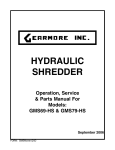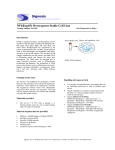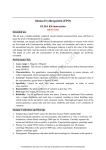Download Rat VEGF R-2 ELISA Kit Manual
Transcript
www.fivephoton.com
______________________________________________________________________________________________
NF-{kappa}B RelA
p65 Sandwich Elisa
FIVEphoton
General Protocol
Biochemicals
For research use only.
Not for diagnostics.
This protocol is posted as a reference. Use the protocol shipped
with your kit for your experiments
FIVEphoton Biochemicals
4907 Morena Blvd, Ste 1403
San Diego, CA 92117
Tel: 800-462-4507
Fax: 858 345-5291
Website: www.fivephoton.com
[email protected]
Store:
Safety:
1
o
4 C.
Expires 6 month after arrival.
Stop solution contains acid.
Avoid all contact and inhalation.
Copyright © FIVEphoton Biochemicals, 2013
www.fivephoton.com
_______________________________________________________________________________
BACKGROUND
This ELISA kit targets the RelA (p65) subunit of NF-kappa B, using a 96-well strip plate coated with affinity purified
antibody specific for p65, together with a provided p65 peptide to calibrate absorbance to p65 concentration. A
horse-radish peroxidase (HRP) conjugated polyclonal antibody and chromogens are employed for colorimetric
detection.
Simultaneous addition of a dilution series of standard peptide as well as assay samples are applied to
individual wells. Following a 30 min – 1 hr incubation period, unbound material is washed, and the HRP conjugated
antibody is added to wells.
After an additional 30 min – 1 hr incubation, unbound antibody is rinsed and chromogen
solutions are added to the wells.
stopping.
The reaction between chromogens and HRP is allowed to proceed for 15 min prior to
An absorbance multiplate reader is employed to measure OD at 450 nm.
Correlation of absorbance in the
assay samples with the peptide standard, provided at known concentration, is used to determine p65 concentration in
the assay samples.
Standards concentrations and assay ranges:
Species
Standard Peptide Concentration
Assay Range
Human
2250 pg/ml
100 – 2000 pg/ml
Mouse
1800 pg/ml
50 – 1500 pg/ml
Rat
2700 pg/ml
30 – 1800 pg/ml
Table 1.
Provided Materials in the Kit
Materials provided with the kit
96 determinations
Storage
User manual
1
Closure plate membrane
2
Sealed bags
1
Microelisa strip plate
1
2-8℃
Standard
0.5ml×1 bottle
2-8℃
Standard diluent
1.5ml×1 bottle
2-8℃
HRP-Conjugate reagent
6ml×1 bottle
2-8℃
Sample diluent
6ml×1 bottle
2-8℃
Chromogen Solution A
6ml×1 bottle
2-8℃
Chromogen Solution B
6ml×1 bottle
2-8℃
Stop Solution
6ml×1 bottle
2-8℃
Wash solution (30X)
20ml×1 bottle
2-8℃
Materials required but not supplied
o
1.
37 C incubator
2.
Standard microplate reader
3.
Distilled water
____________________________________________________________________________________
FIVEphoton Biochemicals, 4907 Morena Blvd, Ste 1403, San Diego, CA 92117
`Tel: 800-462-4507, Fax: 858-345-5291
Page 2 of 6
www.fivephoton.com
_______________________________________________________________________________
4.
Disposable tubes for sample dilution
5.
Absorbent paper
Important notes and preparation for the assay
1.
It is recommended that the experimenter perform preliminary tests using reagents of this kit to identify the sample
dilution required to meet the assay range.
and low dilution.
Perform a preliminary assay with samples, using standards at the high
Suspend and dilute experimental samples into the “sample diluent” provided with this kit to
meet the requirements of the assay range.
A dilution series of several samples may be required to identify the
correct concentration that meets the assay range.
Concentrate or dilute test samples if adjustment is needed.
Set aside sufficient experimental sample for reserve to repeat the assay.
2.
Determine whether the sample vehicle reacts with the assay:
Dilute the sample in sample diluent or prepare
samples in another vehicle to prevent inadvertent experimental readings.
3.
The kit should be equilibrated to room temperate for 30 min prior to performing the assay.
Store opened
o
microelisa plates in a sealed plastic bag at 4 C. A multi-channel sampler that has been calibrated for accuracy is
a preferred method to apply samples.
Plates should be sealed during the assay. Wells should not be allowed to
dry.
4.
Perform dilution of the standards in separate tubes or 96-well plates, not in the ELISA wells.
Transfer solutions
simultaneously to the ELISA dish.
5.
It is recommended that samples are assayed in duplicate to address pipetting error.
6.
Use new applicator tips and ELISA plate sealants to avoid cross-contamination.
7.
Do not mix reagents from other ELISA kits.
8.
Note that sodium azide in samples that is not washed away may inhibit HRP.
9.
When calculating concentration of your sample from the assay, make sure to take into account the dilution factor.
10.
If wash solution crystallizes during storage at 4 C, heat solution at 37 C and shake until crystals suspend.
o
Sample preparation for p65(RelA) ELISA assay.
o
Using ELISA to measure NF-B activation.
p65(RelA) is localized in cells in the cytosol and in the nucleus.
NF-B is activated.
It translocates from the cytosol to the nucleus when
To isolate a total cellular p65(RelA) pool for ELISA assay, use a non-denaturing detergent lysis
buffer such as the Fivephoton Biochemicals ELISA Lysis Buffer (Part ELSP-1).
The protocol associated with the lysis
buffer can be used to assay the total p65 cellular pool.
This ELISA assay can also be used to measure NF-B activation by partitioning a cytoplasmic and nuclear p65 pool
and assaying the concentration of p65 in the respective cellular compartment.
cytoplasmic p65 provides an index of NF-B activation.
The ratio of nuclear relative to
The Fivephoton Biochemicals Nuclear Protein Isolation Kit
(Part NPI-1), or similar, and the associated protocol, can be employed to isolate nuclear and cytoplasmic fractions for
ELISA.
Assay procedures
Standard and Sample Preparation.
Standards, samples and blanks should be added simultaneously to wells.
Prepare the standards, samples and blanks in a separate 96-well dish and transfer simultaneously to the ELISA dish.
____________________________________________________________________________________
FIVEphoton Biochemicals, 4907 Morena Blvd, Ste 1403, San Diego, CA 92117
`Tel: 800-462-4507, Fax: 858-345-5291
Page 3 of 6
www.fivephoton.com
_______________________________________________________________________________
Assay procedure
1.
Set aside and mark 12 wells for standard peptide dilutions.
Configure six concentrations of standard
peptide in duplicate, suspended and mixed as indicated below in separate tubes, or in a separate 96-well
dish.
Do not use the ELISA wells directly to perform the dilutions:
there should be 6 wells in duplicate.
The final sample volume in each well should be 50l.
Table 2.
Standard dilutions (Displayed below for rat;
mouse and human use a similar dilution
protocol).
1800 pg/ml
100μl Standard peptide
Standard No. 6
mix.
1200 pg/ml
+
50μl standard diluent,
Remove 100μl to make Standard No. 5.
100μl Standard No. 6 + 50μl standard diluent, mix.
Standard No. 5
Remove 100l to make Standard No. 4.
600 pg/ml
100μl Standard No. 5 + 100μl Standard diluent, mix.
Standard No . 4
Remove 50l to make Standard No. 3.
Remove and
discard 100l.
300 pg/ml
50μl Standard No. 4 + 50μl Standard diluent, mix.
Standard No . 3
Remove 50l to make Standard No. 2.
150 pg/ml
50μl Standard No. 3 + 50μl Standard diluent, mix.
Standard No. 2
Remove 50l to make Standard No. 1.
75 pg/ml
Standard No. 1
50ml Standard No. 2 + 50ml Standard diluents, mix.
Remove and discard 50l.
2.
Set up 2 blank wells separately.
In blank wells, add 40l sample diluent and 10l solution used to
solubilize the samples (i.e. vehicle);
do not add sample. Perform all other procedures of the assay,
except do not add HRP conjugated antibody to the blank wells.
3.
For wells with experimental samples, add 40μl sample diluent in each well, then add 10μl of sample
diluted in sample diluent.
This creates a 5X dilution factor of sample which should be accounted for later
when calculating sample concentration.
4.
Transfer the Standard Solutions, Blank Well Solutions and Experimental Samples simultaneously to the
ELISA dish from the 96-well dish used for solution preparation.
5.
Use the closure membrane (or a zip lock bag) to enclose the plate, mix gently with a rotating table, and
o
incubate for 30 min at 37 C, or 1 hr at RT.
6.
Dilute the 30X Wash Solution with dH20.
Make 3 ml of diluted wash solution for each assay well.
7.
After the first incubation period, discard the liquid in the wells by gently aspirating.
Turn the plate upside
down and gently pat dry the plate with an absorbent paper. To wash the wells, fill each well with 100 l of
____________________________________________________________________________________
FIVEphoton Biochemicals, 4907 Morena Blvd, Ste 1403, San Diego, CA 92117
`Tel: 800-462-4507, Fax: 858-345-5291
Page 4 of 6
www.fivephoton.com
_______________________________________________________________________________
diluted Wash Solution, oscillate gently with the rocker table for 30 sec, and then aspirate off liquid.
dry the microplate with absorbent paper.
8.
Pat
Repeat the wash steps 5 times.
Simultaneously transfer 50 l HRP-conjugate reagent to each well, except for blank wells. Rotate gently at
o
37 C for 30 min or R
9.
Wash the wells as described in above 5 times.
Remove liquid from the wells.
10. Transfer 50 l of Chromogen Solution A and then 50μl of Chromogen Solution B to each well (prepare
these solutions beforehand in a separate 96-well dish).
11. Simultaneously add 50 l of Stop Solution to each well.
o
Gently mix for 15 min at 37 C in the dark.
Upon addition of stop solution, the blue color
should immediately change to yellow.
12. Measure the optimal density (OD) at 450 nm within 15 minutes of adding the stop solution.
Set the blank
wells as zero.
13. If sample readings are higher than the most concentrated standard, you may wish to dilute the samples
and assay again.
Data Analysis
1.
Compile a standard curve using the blank standard solutions and the corresponding OD values.
You
may wish to calculate a linear regression equation from the standard curve to determine the concentration
of your samples.
Remember that samples were diluted 5 fold in the assay in your final calculation.
Other forms of analysis to calculate concentrations of your samples can also be applied.
Flow chart of the procedures
Prepare standards, blank and samples
o
Add samples to wells, incubate for 1 hr at RT or 30 min at 37 C.
Wash each well five times.
o
Add HRP conjugate antibody to each well, incubate for 1 hr at RT or 30 min at 37 C.
Wash each well five times
____________________________________________________________________________________
FIVEphoton Biochemicals, 4907 Morena Blvd, Ste 1403, San Diego, CA 92117
`Tel: 800-462-4507, Fax: 858-345-5291
Page 5 of 6
www.fivephoton.com
_______________________________________________________________________________
o
Add chromogen solutions A and B, 15 min at 37 C
Add stop solution
Measure OD 450 nm within 15 min
____________________________________________________________________________________
FIVEphoton Biochemicals, 4907 Morena Blvd, Ste 1403, San Diego, CA 92117
`Tel: 800-462-4507, Fax: 858-345-5291
Page 6 of 6









